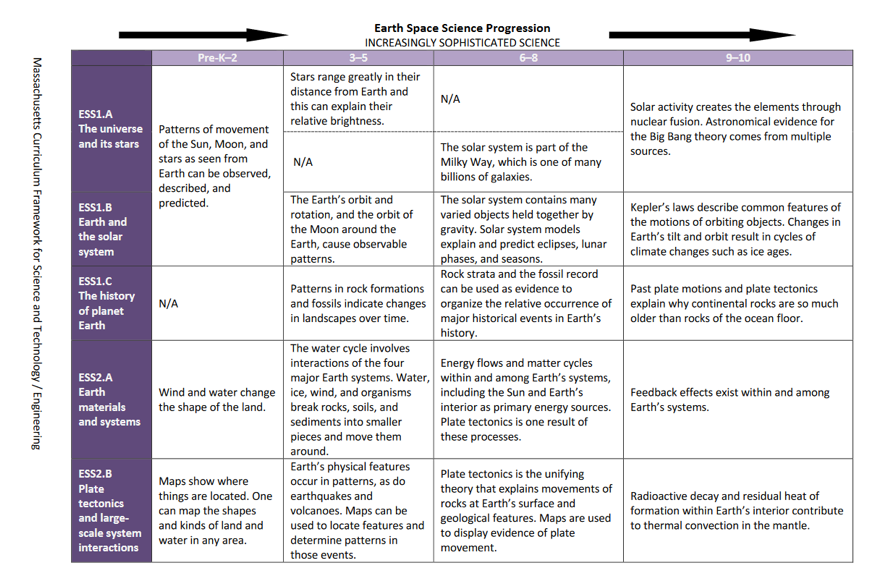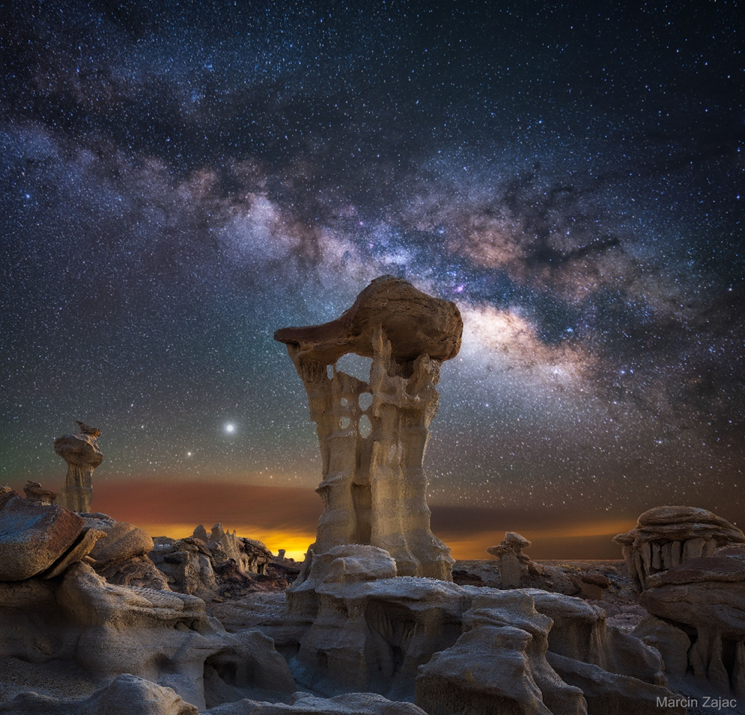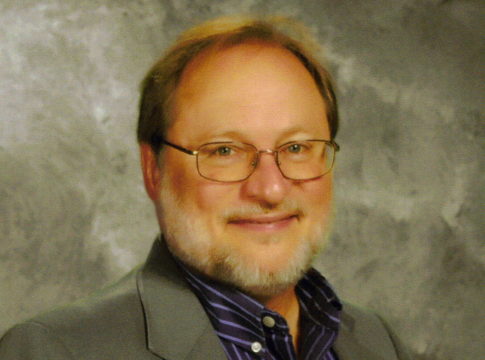(William H. Waller, Endicott College and The Galactic Inquirer)
(August 2020)
INTRODUCTION:
The Earth sciences address processes within and among the rocky Earth, its ice caps, oceans and atmosphere. The space sciences consider Earth as a planet among other planets in the Solar System and the greater cosmos – what is commonly called astronomy. Together, the Earth and space sciences span what we know – and what we would like to know – about our place in space and moment in time. The Earth & space sciences, in concert with the life sciences, comprise what is commonly known as the natural sciences. In this essay, I argue in support of teaching the Earth & space sciences together, so that students can attain a more holistic understanding of their planetary environment, how it came to be, and where it is headed. Such teaching (and teachers) should receive the same priority as in the teaching of physics, chemistry, and biology. My reasoning for bundling and advancing Earth & space science education has pedagogical, scientific, and cultural underpinnings. These will be discussed along with ideas for enhancing the interaction, cooperation, and coordination of Earth & space science educators worldwide.
PEDAGOGICAL UNDERPINNINGS:
Many K-12 school systems already bundle the Earth and space sciences. For example, the Next Generation Science Standards (NGSS, 2012) in the United States have “Earth & Space Sciences” at the same level of priority as the disciplines of “Physical Sciences,” “Life Sciences,” and “Engineering, Technology, and Application of Science.” In my home Commonwealth of Massachusetts, the MA Science and Technology/Engineering Curriculum Framework (2016) lists “Earth and Space Science” along with “Biology,” “Chemistry,” “Introductory Physics,” and “Technology/Engineering” as the key high-school STE disciplines. These same core disciplines are treated in a more integrated/interdisciplinary manner within the K-5 and 6-8 grade spans.
In Japan, science learning in the lower secondary levels is represented by courses in “Physical Science” and “Biology and Earth Science.” In the latter discipline, the skills for observation and experimentation are developed across multiple scales – from the molecular and cellular to the cosmic (see the curriculum listings by country in the TIMSS 2015 encyclopedia).

U.S. Next Generation Science Standards (NGSS) content areas for the sciences.

Massachusetts Earth & Space Science conceptual progression (portion).
By contrast, in Portugal, students transition from learning “Natural Sciences” in grades 5-6, to learning “Natural Sciences,” “Physics & Chemistry,” and “Geography” in grades 7-9, and learning “Biology,” “Geology,” and “Physics & Chemistry” in grades 10-12. Here, it is not at all clear where/when astronomy and space science would be taught. Similarly, science education systems in Brazil and many other countries worldwide cover the “holy trinity” of “Biology,” “Chemistry,” and “Physics” to the detriment of Earth & space science education (see the Wikipedia entry for “Science Education”). I should finally note that even in the Commonwealth of Massachusetts and other U.S. states, many schools do not live up to their mandate of including Earth & space sciences as part of their core science curricula along with the attendant supports. Exacerbating this situation, approximately 40% of all Earth Science teachers have not taken any courses in these sciences (“The Status of Secondary Earth Science Education,” Weiss 2002). This shortfall of commitment to learning and teaching Earth & space sciences is reflected in the job openings for high-school science teachers, as shown below. Clearly, we need to do better to ensure more robust Earth & space science educational programming in our secondary and post-secondary schools.

Distribution of job opportunities for science teachers.
SCIENTIFIC UNDERPINNINGS:
Because of the limited science curricula that exist in many countries, myriad students are missing out on understanding the most important science experiment being conducted worldwide, namely the anthropogenic introduction of additional greenhouse gases into Earth’s atmosphere and the resulting global warming and attendant environmental consequences that are increasingly plaguing us. I contend that this existential environmental crisis is best understood in the context of learning about Earth as a planet that is being irradiated by a star (the Sun), whose warmed surface is then re-radiating its thermal energy at infrared wavelengths, and whose atmosphere selectively traps this re-radiation in ways that depend on the atmosphere’s chemical composition. In other words, a holistic Earth & space sciences approach is called for, if we are to get a grip on why average yearly temperatures are increasing, warm seasons are expanding, storms and forest fires are intensifying, ice caps and glaciers are melting, sea levels are rising, sources of fresh water are depleting & degrading, while sundry species of plants and animals are reeling.

Trapping of Earth’s infrared re-radiation by greenhouse gases
(Center for Climate and Energy Solutions)
The learning of Earth & space sciences also engenders a greater appreciation for our vital connections with the dynamic cosmos. From the Hot Big Bang that gave rise to all matter and energy, to the swirling Milky Way galaxy that spawned our Solar System, and to the wet living planet that we have since inherited, students can become eyewitnesses to essential stories of origin and evolution that continue to play out on multiple spatial and temporal scales.

Schematic history of the Universe.
CULTURAL UNDERPINNINGS:
Discoveries and insights from the Earth & space sciences continue to enthrall people worldwide. Our national parks enjoy enormous popularity. Some of the most visited parks, such as Grand Canyon, Yosemite and Yellowstone, have amazing geological stories to tell. That is no accident, as the awesome rock formations in these parks embody the incredible forces at work in shaping and exposing them. These parks also provide key “dark-sky” sanctuaries for observing the Milky Way and sundry other celestial wonders. Back in our cities, planetariums continue to draw many millions of people each year to their astronomical presentations. Meanwhile, stunning images from our earth-based and spaceborne observatories have kindled ever-increasing fascination for the heavens that spans many nationalities and cultures. Our planetary probes continue to excite our collective curiosity, while our preparations for humans re-inhabiting the Moon and venturing to Mars inspire fascination and enthusiasm – especially among our children. Given humanity’s natural attraction to the wonders of Earth & space, why not leverage this appeal in order to increase overall scientific awareness and literacy?

Hoodoos and Milky Way as viewed from the New Mexico badlands.
RELEVANCE TO STEAM EDUCATION:
STEAM education refers to the teaching and learning of Science, Technology, Engineering, Arts, and Mathematics. The burgeoning industries of Information Technology (IT), Robotics, and Biotechnology, in particular, have prompted ever-increasing calls for beefing up our Technology and Engineering education programs. Other motivators for enhancing STEAM education worldwide pertain to the severe environmental challenges that we currently face. Consequently, many colleges now offer programs in environmental science and environmental engineering. The Earth & space sciences inform these fields by providing the essential physical context for understanding natural ecosystems and their responses to human inputs. Conversely, the Earth and space sciences critically depend on technological advances in remote sensing, spacefaring, telecommunications, big data, robotics, and human factors in exploring hostile environments.

Mars Perseverance rover (artist’s conception) is due to land on Mars in February 2021 (NASA).
PRECEDENTS:
Undergraduate and graduate programs in Earth & space science education are currently offered by Arizona State University, Brigham Young University, Illinois State University, Purdue University, St. Cloud State University, and Temple University among others. These programs combine courses in science pedagogy with courses in the core sciences, mathematics, and Earth & space sciences. Other institutions provide similar education programs but under more restrictive titles, e.g. Geoscience Education, Earth Science Education, Astronomy Education, etc.
Supporting these and other programs in Earth & space science education, several stakeholder institutions have come forward to provide resources and training. These include NASA’s Science Mission Directorate (SMD) with its “Science Activation” and “Universe of Learning” programs that together encompass Earth Science, Planetary Science, Heliophysics, and Astrophysics. The NASA Earth Science Education Collaborative (NESEC) and NASA Space Science Education Consortium (NSSEC) also provide opportunities for further experiential training. Other stakeholder institutions in support of Earth and space science education include the International Astronomical Union (IAU) and its associated national astronomical associations (such as the American Astronomical Society [AAS]), corresponding geophysical unions (such as the American Geophysical Union [AGU]), oceanographic and meteorological associations (such as the American Meteorological Society [AMS]), as well as their umbrella organizations — the various national academies and associations of science.
CALL TO ACTION:
To effectively bundle and advance Earth & space science education worldwide, our stakeholder institutions need to do a better job of interacting, cooperating, and coordinating. That includes
- Science and education departments in colleges and Universities.
- Earth & space science organizations (e.g. NASA, ESA, AGU, EGU, IAU, AAS, etc.)
- National associations of science educators (NSTA, NAGT, NESTA, NASE, ASP, etc.)
- State boards of education (MA DESE, CA Dept. of Education, etc.)
I recommend that the IAU and AGU get the ball rolling by first establishing relations with the largest astronomical, geophysical, oceanographic, and meteorological associations. Once we have agreed upon tangible cooperative goals and strategies towards advancing Earth & space science education worldwide, we could then reach out to engage the larger national science academies and associations along with national organizations of science teachers.
REFERENCES:
Next Generation Science Standards (2012)
https://www.nextgenscience.org/
Massachusetts Science and Technology/Engineering Curriculum Framework (2016)
http://www.doe.mass.edu/frameworks/scitech/2016-04.pdf
California State Science Framework (2016)
https://www.cde.ca.gov/ci/sc/cf/cascienceframework2016.asp
TIMSS 2015 Encyclopedia
http://timssandpirls.bc.edu/timss2015/encyclopedia/
Science Education (Wikipedia)
https://en.wikipedia.org/wiki/Science_education
NASA Science Mission Directorate (SMD) Education & Public Outreach
International Astronomical Union Education & Public Outreach
American Astronomical Society Education & Public Outreach
Astronomical Society of the Pacific Education & Outreach
https://astrosociety.org/education-outreach/programs.html
American Geophysical Union Education & Public Outreach
American Meteorological Society Education & Public Outreach
https://www.ametsoc.org/index.cfm/ams/education-careers/education-program/
National Ocean Service Education
https://oceanservice.noaa.gov/education/
International GeoScience Education Organization
National Science Teachers Association (NSTA)
HIGH SCHOOL TEXTBOOKS IN EARTH & SPACE SCIENCES
Earth and Space Sciences for NGSS, BIOZONE, 2016
https://www.thebiozone.com/products/nes1/earth-and-space-sciences-for-ngss-student-edition-biozone/
Earth and Space Science: Student Text, Kristine Lindsay, Pro-Ed, 2007
https://www.proedinc.com/Products/20205/earth-and-space-science-student-text.aspx
(Does not go beyond the Solar System)
Earth & Space Science: Exploring the Universe, Gustavo Loret de Mola, McGraw Hill Education, 2009
Physical, Earth, and Space Science, Thomas C. Hsu, Frey Scientific, 2010
https://freyscientific.com/curriculum/cpo-science/core-curriculum/physical-earth-space-science
Cosmology and Astronomy, Khan Academy (includes Earth Science)
https://www.khanacademy.org/science/cosmology-and-astronomy
Conceptual Integrated Science Explorations, Third Edition, P. G. Hewitt, S. Lyons, J. Suchocki, & J. Yeh, Pearson, 2020 (includes physics, chemistry, biology, Earth & space sciences)
